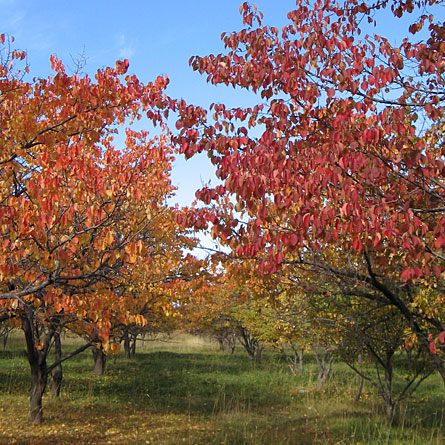Compare apples with apples, a researcher says, and red leaves on fall fruit trees look like they may be a warning to aphids.

Most domesticated varieties of apple trees don’t flare into red foliage in the fall, but a few do — as do their wild relatives, says Marco Archetti of Harvard University. Archetti used that color variety to test whether autumn reds signal trees with robust chemical defenses against pests.
Aphids don’t show up as frequently on apple trees that turn red in the fall as on those that stay green or yellow, he reports online April 14 in Proceedings of the Royal Society B. Also, young aphids feeding on those formerly red trees in spring weren’t as likely to grow to maturity as aphids on trees that turned green or yellow in the fall. The findings support the idea that red coloring in autumn trees could be a stop sign for insects, says Archetti, who conducted the research while at the University of Oxford.
The question of why some leaves turn red in fall has nagged at biologists as a sort of rearranging-the-deck-chairs-on-the-Titanic problem. Leaves in fall are dying, and their green chlorophyll degrades to unmask any yellow pigments. But some doomed leaves, for reasons still not clear, take the energy to redecorate, synthesizing anthocyanin pigments for red foliage. The idea that the fiery foliage may serve as a warning color that discourages insect infestations has sparked lively debate since Archetti published the first paper on it in 2000.
“The nice thing about this article is that it collects and reports important new data on the phenomenon,” says David Lee of Florida International University in Miami. But he still questions some of the interpretations. And says the paper hasn’t wooed him away from his contention that anthocyanins protect leaf chemistry from light damage at cool temperatures.
Archetti says that the signaling idea came from the late William Hamilton, who mused that the bright red colors might have evolved in the war between trees and their pests. Perhaps trees that could synthesize such brilliant reds were trees with defenses so robust that insects would do well to look elsewhere.
Aphids are a convenient pest group for testing the idea. Fall is the season for sex, when many aphid species leave their summer plants to find a good tree for mating and egg laying. Aphids can damage trees in two ways, especially when the new generation hatches in the spring. The insects steal the sap and also spread diseases with their piercing mouthparts that end up as entomological dirty needles. So trees would do well to dodge aphids.
Though aphids don’t have a vision receptor specialized in red, Archetti and Thomas Döring, now at the Organic Research Centre in Hamstead Marshall, England, published data earlier this year showing that aphids do respond differently to red and green, on average. Döring says, “I still believe that the red is very unlikely to be a signal,” but he acknowledges that their data “did not strictly exclude the possibility of a signal.”
A perfect test of the coevolution hypothesis is tricky without traveling back in time, but Archetti says his work approximated that by taking advantage of a millennium of apple domestication. After visiting central Asia, the ancient center of apple diversity, to observe the flaming reds of wild trees and assessing more than two thousand cultivated varieties in the Brogdale collection in England, Archetti concluded that apples have largely lost their red foliage during domestication. He says he can’t see why that would have happened if the red colors were so valuable for protecting leaf chemistry, but the loss does make sense if farmers were selecting for other qualities.







